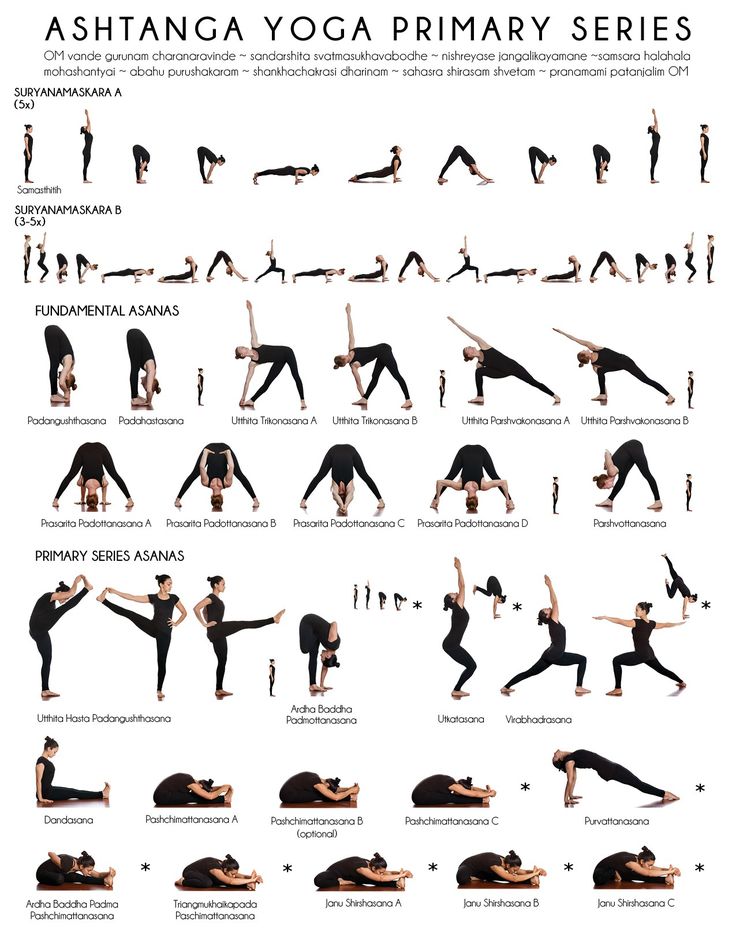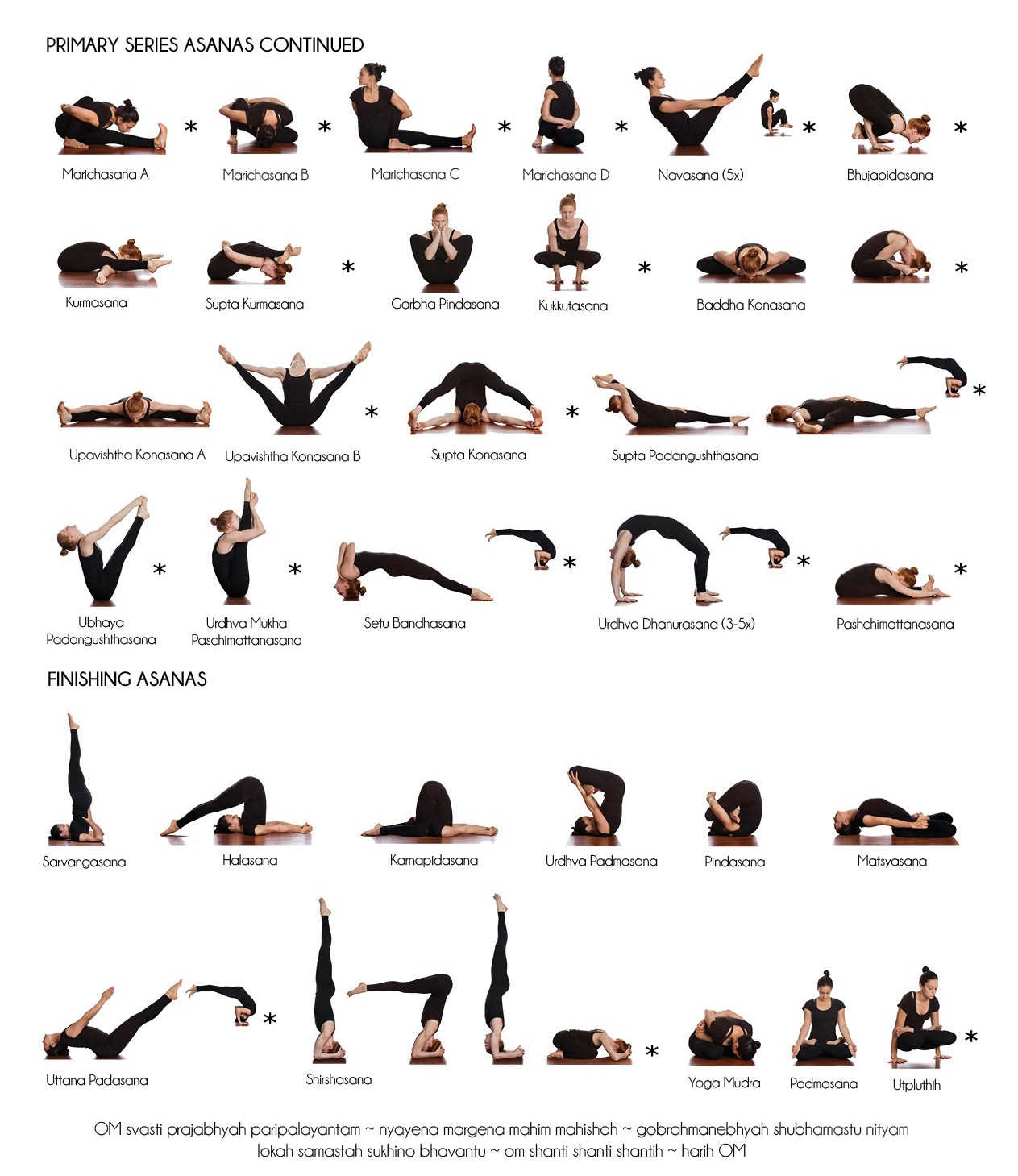What is Ashtanga Vinyasa Yoga?
Ashtanga Vinyasa Yoga is a system of yoga recorded by the sage Vamana Rishi in the Yoga Korunta, an ancient manuscript. The text of the Yoga Korunta was imparted to Sri T. Krishnamacharya in the early 1900's by his Guru Rama Mohan Brahmachari, and was later passed down to Pattabhi Jois during the duration of his studies with Krishnamacharya, beginning in 1927.
Ashtanga Yoga literally means 'eight-limbs' as outlined by the sage Patanjali in the Yoga Sutras. According to Patanjali, the path of internal purification for revealing the Universal Self consists of the following eight spiritual practices:
- Yama (moral restraints)
- Niyama (observances)
- Asana (posture)
- Pranayama (breath extension)
- Pratyahara (sense withdrawal)
- Dharana (concentration)
- Dhyana (meditation)
- Samadhi (meditative absorption)
According to Pattabhi Jois, a person must first take up daily asana practice to make the body strong and healthy. With the body and sense organs thus stabilized, the mind can be steady and controlled. With mind control, one is then able to pursue and grasp the other limbs.
Benefits of Ashtanga Vinyasa Yoga:
- Builds Strength
- Increases Flexibility
- Weight Management
- Develops Muscle Tone
- Promotes Detoxification
- Increases Energy & Vitality
- Relieves Back Pain & Injuries
- Improves Digestion & Circulation
- Increases Co-ordination & Balance
- Lubricates Joints, Ligaments & Tendons
- Calms the Mind
- Reduces Stress, Tension & Anxiety
- Improves Concentration & Memory
- Promotes Relaxation
- Better Quality Sleep
- Improves Lung Capacity
- Lower Blood Pressure
- Boosts Brain Function
- Enhances Self-Confidence
- Creates Inner Peace & Happiness
Ashtanga Vinyasa Yoga Method
VINYASA SYSTEM
Ashtanga Vinyasa Yoga, usually referred to simply as Ashtanga Yoga, is a sequence for postures (asana) linked together by breath and movement. To perform asana correctly in Ashtanga Yoga, one must incorporate the use of vinyasa and tristhana. Vinyasa means breathing and movement system. For each movement, there is one breath. One breath, one movement! In this way all asanas are assigned a certain number of vinyasas. The purpose of vinyasa is for internal cleansing. Synchronizing breathing and movement in the asanas heats the blood, making it clean and thin so that it may circulate more freely. Improved blood circulation relieves joint pain and removes toxins and disease from the internal organs. The sweat generated from the heat of vinyasa then carries the impurities out of the body. Through the use of vinyasa, the body becomes healthy, light and strong.
TRISTHANA
The practice of Ashtanga Vinyasa Yoga combines three elements:
- Body (asana)
- Breath (pranayama)
- Mind (drishti)
This is also known as the Tristhana Method, or three places of attention. These three places are very important for yoga practice, and cover three levels of purification: the body, nervous system and mind. They are always performed in conjunction with each other. The tristhana method actively draw the senses inward allowing practitioners to move through the Asthanga series with complete awareness and presence, transforming the physical asana practice into a moving meditation.
ASANA:
The method for purifying and strengthening the body is called asana. In the Ashtanga Vinyasa Yoga system, asana is grouped into six series:
* Primary Series, also called Yoga Chikitsa meaning Yoga Therapy.
* Intermediate Series, also called Nadi Shodhana meaning Nervous System Purification.
* Advanced Series A, B, C & D are collectively known as Sthira Bhagameaning Steady Strength.
Each level is to be fully developed before proceeding to the next, and the sequential order of asanas is to be meticulously followed. Each posture is a preparation for the next, developing the strength and balance required to move further. Without an earnest effort and reverence towards the practice of yama and niyama, however, the practice of asana is of little benefit.
PRANAYAMA:
The breathing technique performed with vinyasa is called ujjayi pranayama, meaning victorious breath, which consists of puraka (inhalation) and rechaka (exhalation). Both the inhale and exhale should be steady and even, the length of the inhale should be the same length as the exhale. Over time, the length and intensity of the inhalation and exhalation should increase, such that the increased stretching of the breath initiates the increased stretching of the body. Long, even breathing also increases the internal fire and strengthens and purifies the nervous system.
BANDHA:
Bandhas are essential components of the ujjayi breathing technique. Bandha means "lock" or "seal". The purpose of bandha is to release pranic energy and direct it into the nadis (energy channels) of the subtle body. Mula bandha is the anal lock, and uddiyana bandha is the lower abdominal lock. Both bandhas seal in energy, give lightness, strength and health to the body, and help to build a strong internal fire. Mula bandha operates at the root of the body to seal in prana internally for uddiyana bandha to direct the prana upwards through the nadis. Jalandhara bandha is the "throat lock", which occurs spontaneously in a subtle form in many asanas due to the drishti (gazing point), or head position. This lock prevents pranic energy from escaping and stops any build-up of pressure in the head when holding the breath. Without bandha control, breathing will not be correct, and the asanas will give little benefit.
DRISHTI:
The pratyahara (sense withdrawal) technique used in Ashtanga Vinyasa Yoga is called Dristhi, meaning looking place. Drishti is the gazing point on which one focuses while performing the asana. The nine looking places are called Nava Drishtis.
- Nasagra (Nose)
- Brumadya (Third Eye)
- Nabi (Navel)
- Padagra (Toes)
- Hastagra (Hand)
- Angushtha (Thumbs)
- Parshva (Right Side)
- Parshva (Left Side)
- Urdhva (Upward)
Dristhi purifies and stabilizes the functioning of the mind. In the practice of asana, when the mind focuses purely on the breath and drishti, the resulting deep state of concentration paves the way for the practices of dharana and dhyana, the six and seventh limbs of Ashtanga Yoga.
THE FINAL GOAL
Practicing asana for many years with correct vinyasa and tristhana gives the student the clarity of mind, steadiness of body, and purification of the nervous system to begin pranayama practice. Through the practice of pranayama, the mind becomes focused and concentrated in a single direction and follows the movement of the breath. Pranayama forms the foundation for the internal cleansing practices of Ashtanga Yoga.
The four internal cleansing practices—pratyahara, dharana, dhyana, and samadhi—bring the mind under control. When purification is complete and mind control occurs, the Six Poisons surrounding the spiritual heart will, one by one, go completely, revealing the Universal Self.
- kama (desire)
- krodha (anger)
- moha (delusion)
- lobha (greed)
- matsarya (sloth)
- mada (envy)
In this way, the correct, diligent practice of Ashtanga Yoga under the direction of a Guru with a subdued mind unshackled from the external and internal sense organs eventually leads one to the full realization of Patanjali's eight-limbed yoga.


